Best of India Tours
- Golden Triangle Tour- Best of India & Nepal
- Classical Rajasthan
India Cultural Tours
- Images of North India- Karnataka Heritage
- Rajasthan & Goa Tour
Discover India Tours
- Grand India Tour- North to South India
- Central to South India
Rajasthan Tours
- Classical Rajasthan Tour- Golden Triangle Tour
- Grand Mughal Tour
India Luxury Trains
- Palace on Wheels- The Golden Chariot
- India Deccan Odyssey
- The Indian Maharaja
- Royal Rajasthan on Wheels
Nepal Tours
- Glimpses of Nepal- Buddhist Pilgrimage
- Nepal River Rafting
- Destinations of Nepal
- Nepal General Info
India Wildlife Tours
- North India Wild Life- South India Wildlife
Tibet Tours
- Tibet Monastery Tours- Explore Tibet
- Destinations of Tibet
Spa & Yoga Tours
- Ananda in Himalayas- Yoga & Meditation
Adventure Tours
- Manali Safari Tour- Himalayan Trekking
- Horse Safari
Ahmedabad
Ahmedabad
![]() Bhavnagar
Bhavnagar
![]() Bhuj
Bhuj
![]() Daman
Daman
![]() Diu
Diu
![]() Gondal
Gondal
![]() Jamnagar
Jamnagar
![]() Sasan Gir
Sasan Gir
![]() Vadodara
Vadodara
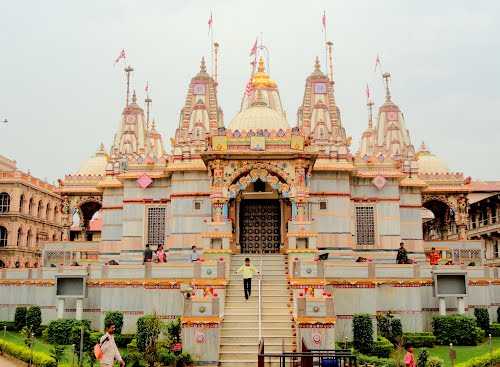
Often referred to as the ’Manchester of the East’, Ahmedabad is situated along the Sabarmati River in the western state of Gujarat. The city contributes about 25 per cent of India’s total textile production.
Founded in AD 1411, the city of Ahmedabad was named after its founder Sultan Ahmed Shah. The city became an important business centre after it was annexed by Mughal Emperor Akbar in AD 1572. In 1818, the city was taken over by the British who set up a number of textile mills here. Ahmedabad was the capital of Gujarat from 1960 to 1970.
Ahmedabad has a hot and humid climate. Temperatures can rise up to 46°C in the summer. The city experiences good rainfall during the monsoon season. Winters are cool and pleasant and are the best times to visit the city. Ahmedabad
Sightseeing
A trip around the Walled City of Ahmedabad will provide the visitor with valuable information of the city’s glorious past. The simplicity of the city is complemented by the charm of the various museums, mosques, and forts spread across the city. The array of artefacts, antiques, and the exotic and colourful attire available for sale in the city is often tempting. The city has numerous places of interest for tourists, ranging from monuments to amusement parks. Some of the places of attraction are the Jama Masjid, Shaking Minarets, Calico Textile Museum, Sidi Sayid’s Mosque, Hathi Singh Temple, Step-Wells, Sabarmati Ashram and Vishala/Veechar (utensils museum).
Excursions
Moving around Ahmedabad, one gets a deeper insight into the architectural excellence of its past. The step-wells or baolis are good places to appreciate the superb craftsmanship of the yesteryears. The Jain and the Hindu temples, besides being religious centres, also excelled as architectural masterpieces. Some of the places to be seen around the city are Sarkhej, Adalaj, Modhera and Patan.
Excursions for Ahemdabad
Jama Masjid
The Jama Masjid of Ahmedabad is one of the most beautiful mosques in the country. Located to the east of the Teen Darwaja besides Mahatma Gandhi road, the mosque was built in AD 1423 by Ahmad Shah. Built in the Indo-Saracenic style, the mosque has 260 columns supporting the roof. The dome is illuminated by the natural light which is reflected into it by the external roofs. One of the major attractions of the mosque is the beautiful stonework of the Muluk-Khana or the Royal Gallery, which is a platform standing on pillars.
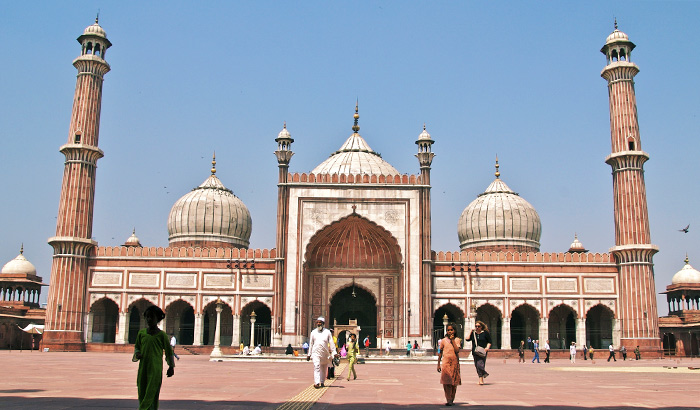
Shaking Minarets
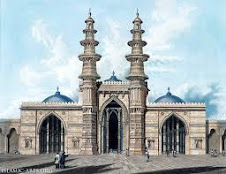
The Sidi Bashir Mosque, commonly known as the Shaking Minaret or Jhulta Minar, is located outside the Sarangpur Gate. An interesting thing about the minarets is that if one of the minarets is shaken, the other begins to vibrate on its own. The minarets evoke lot of curiosity and are the major attraction here. The mechanism that causes the vibration is still a mystery and it is believed that that the vibration is a protection against the damage caused by the earthquakes.
Calico Textile Museum
Started in 1949, the Calico museum of fabric, yarn and textiles today houses designs, print and blocks from all over the world. Some the exhibits that attract the attention of a visitor are the paintings on cloth called kalamkari (/’pen work/’), and designs from Rajasthan, Himachal Pradesh, Kashmir, and the North Eastern states of India. The museum also has a collection of marble, sandstone and bronze icons and busts split in two thematic sections—galleries for religious textiles and historical textiles. The Museum is located in Sarabhai House, a former haveli (bungalow) in the Shahi Bagh Gardens locality of the city.
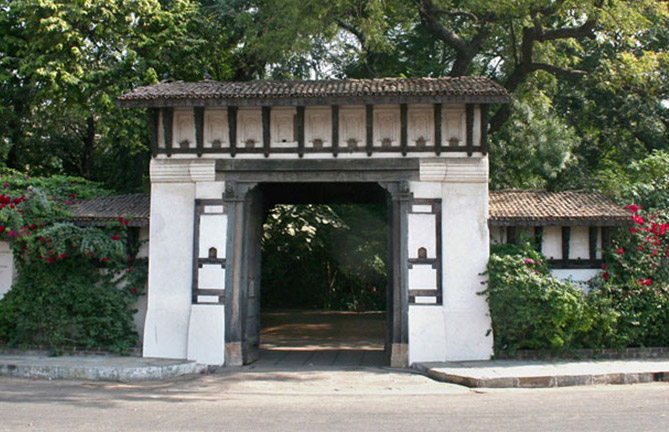
Sidi Sayid/'s Mosque
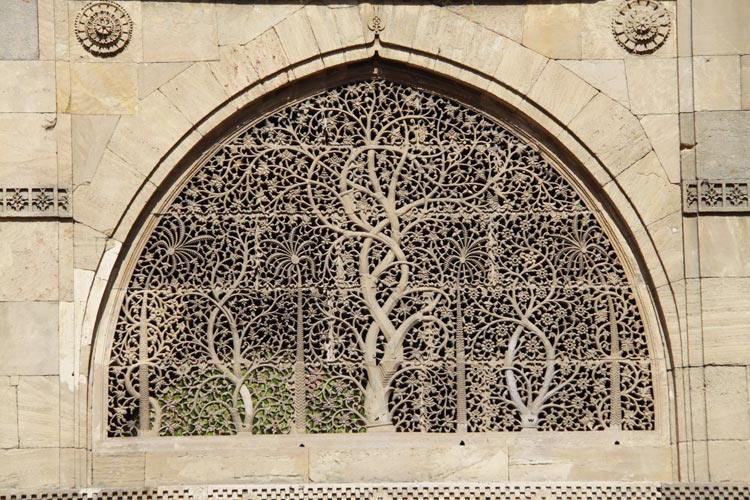
The mosque was built by Sidi Sayid, Ahmad Shah/’s slave, in AD 1573. The mosque is famous for its stone tracery and the motifs of the banyan tree on its windows. It is located near the Lal Darwaza (Red Gateway) and is very close to the river end of the Relief Road.
Hathi Singh Temple
Built in 1848, this two-storeyed structure in pure white marble is dedicated to Dharmanath, the fifteenth Jina or Jain apostle. The temple has 52 shrines, each with an image of a Jain Tirthankara. Located outside the Delhi Gate, the temple is named after its builder Sheth Hathi Singh.
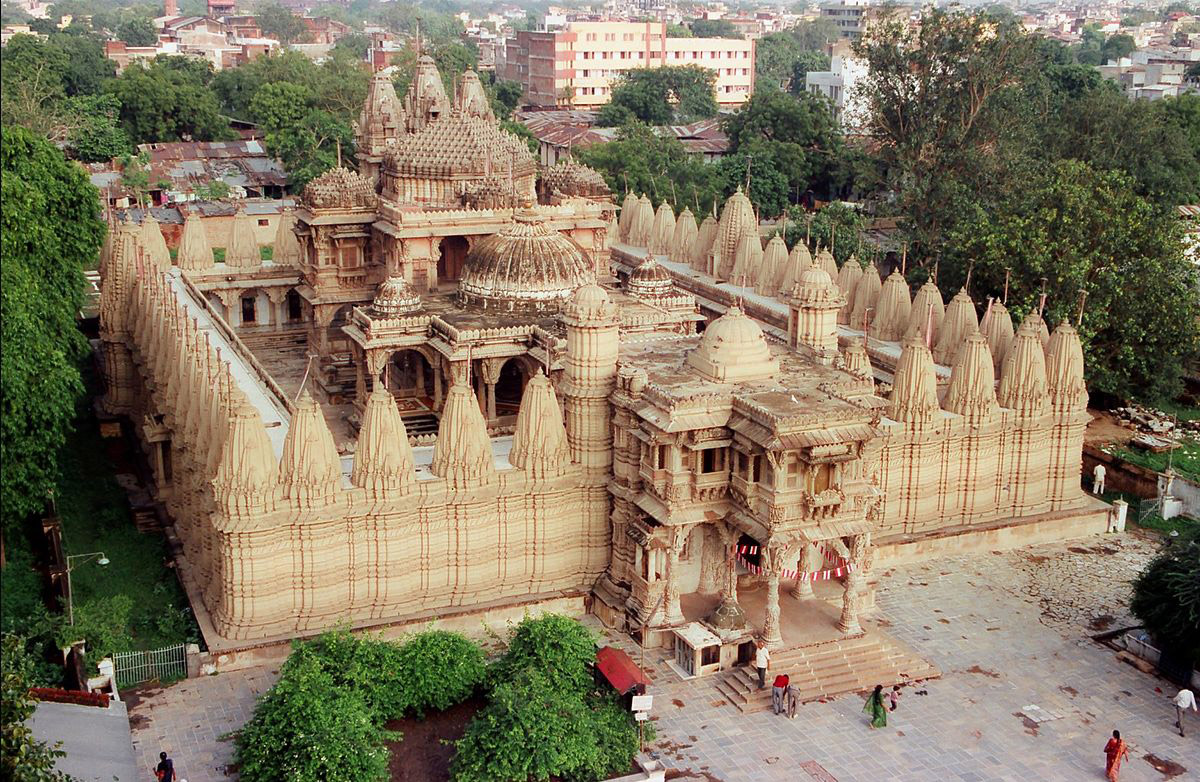
Step-Wells
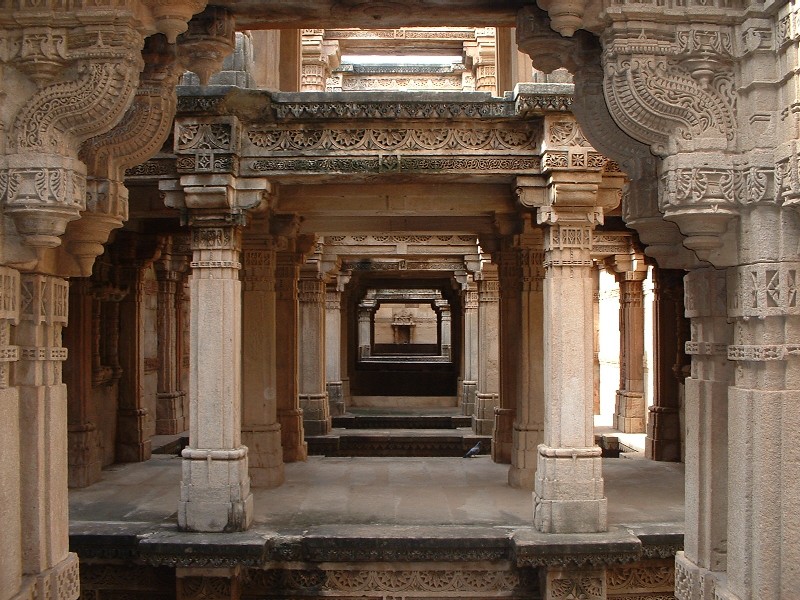
Known as wavs or baolis in the local dialect, the step-wells are constructions unique to North India. The Dada Hari Wav, supposed to be one of the best wells, was built in 1501. The well has a series of steps leading down to the lower platforms terminating at a small octagonal well. Even on the hottest day, the interiors of the well remain quite cool. Though in a neglected state today, the well is a fascinating place to visit.
Sabarmati Ashram
Seven kilometres to the north of the city on a quiet stretch of the river Sabarmati lies the ashram set up by Mahatma Gandhi in 1915. The Sabarmati Ashram, as it is popularly called, was the first Satyagraha Ashram set up by Gandhi. The ashram still makes handicrafts, handmade paper and spinning wheels. Hridaya Kunj, the cottage where Mahatma Gandhi lived, is preserved as it was during his lifetime. The Gandhi Ashram also houses a small memorial. Visitors can have a look at a sound and light spectacle that takes place three days a week.
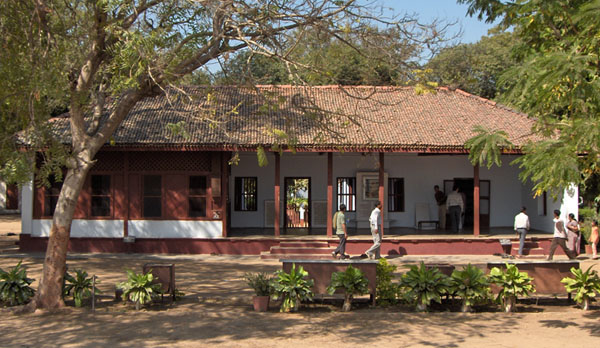
Vishala/Veechar (Utensils Museum)
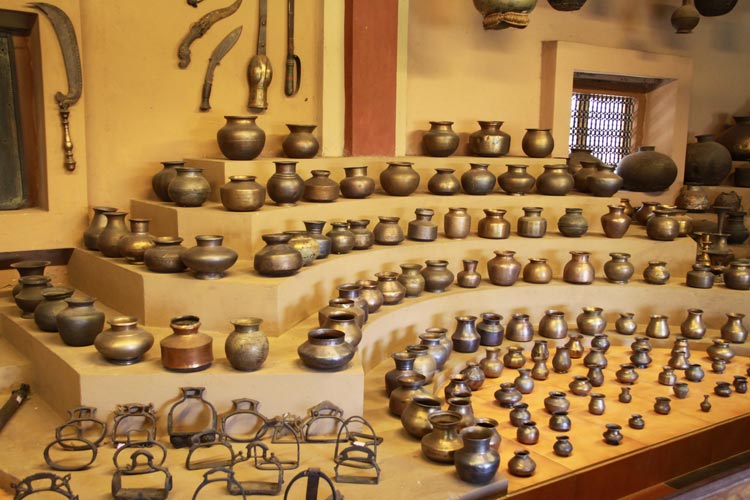
In the compound of the Vishala restaurant is located the Utensils Museum. The museum has a unique collection of nutcrackers, locks and utensils. Vishala serves traditional Gujarati food in village surroundings.
Sidi Syed Mosque - Interior
The mosque was built by Sidi Sayid, Ahmad Shah/’s slave, in AD 1573. The mosque is famous for its stone tracery and the motifs of the banyan tree on its windows. It is located near the Lal Darwaza (Red Gateway) and is very close to the river end of the Relief Road.

Adalaj
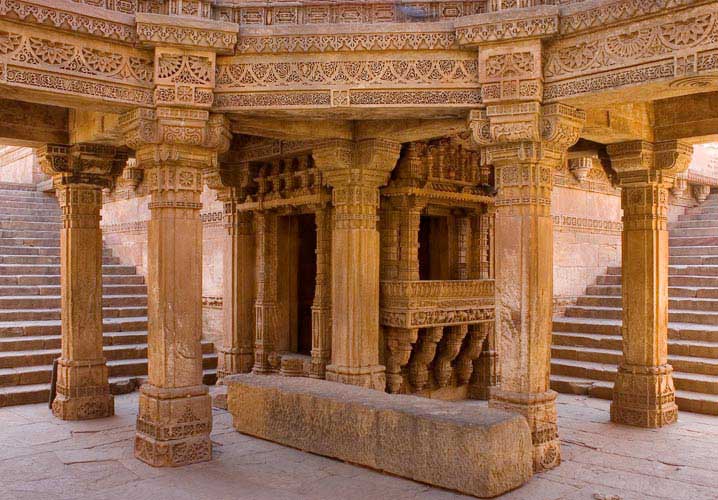
Adalaj is situated about 19 km north of Ahmedabad on Sarkhej-Gandhinagar highway. This step-well was built by queen Rudabai in 1499. The well has three stepped entrances that ascend into an open court. From here, a single arched heavily decorated entrance leads to a corridor. The corridor has four pavilions and is five storeys under the ground up to the well. The monument is best seen around noon, when sunlight penetrates the bottom of the five-storey octagonal well shaft, making the exquisite sculptures, the walls, pillars, cornices and niches portray erotica, dancing maidens, musicians, animals and images of Shiva come alive. Stone elephants, horses and mythical animals are seen around the sides of the shaft.
Modhera
Around 102 km north-west of Ahmedabad lies the town of Modhera. The Sun Temple in this town, built by Raja Bhimdev I, is a major source of attraction here. The Temple has been divided into three main compartments. The first is the Surya Kund, a fascinating massive rectangular stepped tank. The tank now stands dry, but in ancient times it was believed to be full of nirmal jal (holy water). Devotees on their way to offer prayers to the Sun God were required to first stop here for ceremonial ablutions. Several small steps from the Kund lead up to the enchanting
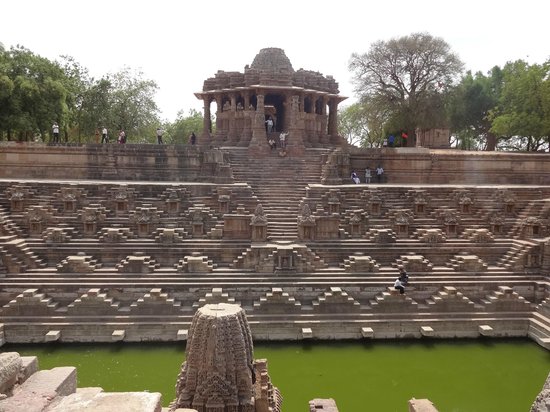
Sabha Mandap. The place was meant for religious gatherings and conferences. Open on all sides with four doorways, the major attraction here is its unique walnut-shaped ceiling supported by 52 spectacular pillars. Each of these pillars is intricately carved with scenes form Ramayana, Mahabharata and the Krishna Leela (the childhood antics of Lord Krishna). The Guda Mandap contains a surang (tunnel), the other end of which is believed to emerge at Patan. These tunnels provided the ideal escape routes for the kings and members of the royal family in case of attacks. From Modhera, one can also take trip to the nearby towns of Unjha, where one can find the fragmented ruins of an ancient temple.
Patan
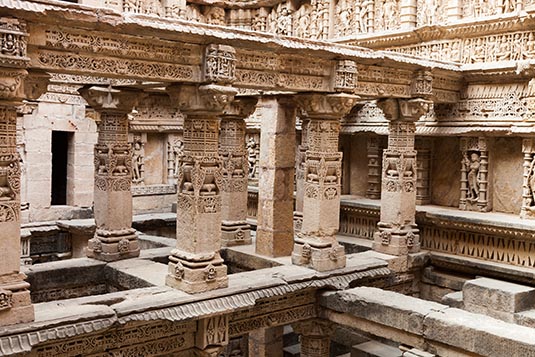
Famous for Patola saris, Patan is situated at about 130 km north-west of Ahmedabad on the banks of the river Saraswati. Originally known as Anhil-Vad-Pattan, the town flourished during the reign of the Solanki dynasty in 8th-11th century. The Queen/’s Step well or Rani-Ki-Vav is one of the most fascinating monuments in the town. Constructed by queen Udayamati (AD 1022-63) and built in the Khajuraho style, the vav is 90 feet wide. Its walls are lined with images of Vishnu, Shiva and other gods and goddesses. Also situated here is the Sahastralinga Talav or tank of a thousand Shiva shrines spread over an area of 5 km
Its construction was carried out by Jayasimha Siddharaja (AD 1093-1143). Among the Jain temples in Patan, said to number over a hundred, the one dedicated to Panchasara Parasvanath is the largest. It has a famous white marble image of Vanaraja. In its vicinity lies the Hemchandracharya Jain Gyan Mandir that contains valuable Jain manuscripts, some of which were written in ink made of gold.
Sarkhej
Sarkhej lies about 8 km from Ahmedabad city. Here one can find some of the most elegant architectural complexes of Ahmedabad. Around a stepped tank lies the tomb of saint Ahmed Khattu Ganj Baksh, the mosque, the tombs of Mahmud Shah Begada and his queen, and the palace and pavilions. The pierced stone trellises have been used throughout the construction of the buildings which are completely devoid of arches.
Fact File
 Area: 204.6 sq. km
Area: 204.6 sq. km
 Population:2,954,526
Population:2,954,526
 Altitude: 3 metres above sea level
Altitude: 3 metres above sea level
 Best Time to Visit: November to February
Best Time to Visit: November to February
 Languages: Gujarati, Hindi and English
Languages: Gujarati, Hindi and English
 STD Code: 079
STD Code: 079




